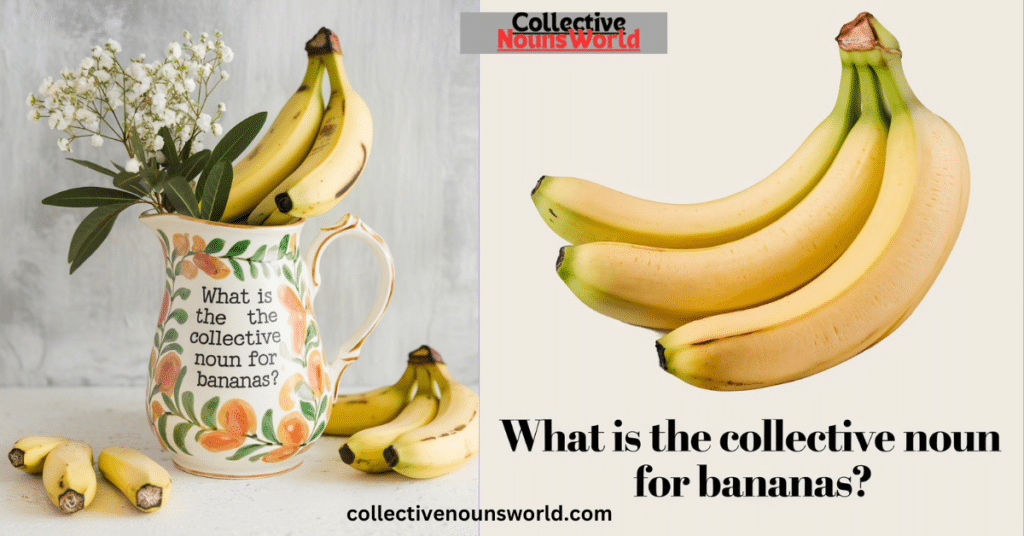Have you ever found yourself staring at a group of bananas in the grocery store, wondering what to call them? You’re not alone on this learning journey. The world of collective nouns is as fascinating as it is diverse, and bananas are no exception. Let’s dive into the bunch (pun intended) of terms used to describe these curved yellow wonders.

The Appeal of Banana Terminology
Bananas, those versatile fruits that grace our fruit baskets and tantalize monkeys, come with their own set of collective nouns. Whether you’re a linguist, a fruit enthusiast, or simply someone who enjoys the quirks of the English language, understanding these terms can add flavor to your conversations and writings.
From the banana plantation to the market display, these terms reflect not just how we group bananas, but also how we perceive and interact with them. Let’s peel back the layers of banana terminology and explore the rich vocabulary surrounding this beloved fruit.
Collective Nouns for Bananas
Before we dive deeper, here’s a quick reference table of the collective nouns we’ll be discussing:
| Collective Noun | Usage Context | Formality Level |
| Bunch | Everyday, General | Casual |
| Hand | Botanical, Commercial | Formal |
| Cluster | Descriptive, Versatile | Semi-formal |
| Comb | Whimsical, Creative | Casual |
| Rack | Commercial, Storage | Semi-formal |
| Stem | Botanical, Structural | Formal |
Now, let’s explore each of these terms in detail, complete with examples and scenarios.
The Bunch: The Classic Choice
When you think of a group of bananas, the word “bunch” likely springs to mind. It’s the most common and widely accepted collective noun for bananas. Picture yourself at the grocery store, reaching for that perfect cluster of yellow goodness. You’re not just grabbing bananas; you’re selecting a bunch.
Examples in Context
Everyday Shopping: Imagine you’re making a grocery list for a family picnic:
To-Do:
1. Buy 2 bunches of bananas
2. Pack the fruit salad ingredients
3. Don’t forget the sunscreen!
- Recipe Writing: A food blogger might write: “For this banana bread recipe, you’ll need one ripe bunch of bananas. The speckled ones are perfect!”
- Market Vendor’s Call: At a bustling farmers market, you might hear: “Fresh bunches of bananas! Get your sweet, ripe bunches here!”
The Hand: A More Technical Term
While “bunch” reigns supreme in everyday language, “hand” is actually the proper botanical term for a cluster of bananas. It refers to the tier of bananas within a larger bunch. This term is often used in more professional or scientific contexts.

Examples in Context
Banana Farm Communication: An email from a banana farm manager to a distributor might read:
Subject: Weekly Harvest Update
Dear Ms. Thompson,
This week’s harvest yielded 500 hands of premium Cavendish bananas. Each hand contains an average of 12 fingers, ensuring ample supply for your stores.
Best regards,
Juan Martinez
Sunshine Banana Farms
- Educational Material: A textbook on tropical agriculture might state: “A typical banana plant produces 5-9 hands per bunch, with each hand containing 12-20 fingers.”
The Cluster: A Versatile Alternative
If you’re looking to shake things up a bit, “cluster” is a great alternative. It’s versatile and vivid, conjuring up images of bananas huddled together in their yellow splendor.
Examples in Context
- Food Photography Description: A magazine article might describe: “The still life featured a vibrant cluster of bananas, their sunny hue contrasting beautifully with the deep purple of nearby plums.”
- Grocery Store Signage: You might see a sign reading: “Pick up a cluster of our organic, fair-trade bananas – perfect for your morning smoothie!”

The Comb: A Charming Option
“Comb” is a less frequently used but equally valid collective noun for bananas. It’s a charming alternative that draws a parallel between the curved shape of bananas and the teeth of a comb.
Examples in Context
- Children’s Story: In a tale about a monkey eating bananas, you might read: “Milo the Monkey swung through the jungle until he spotted a golden comb of bananas hanging just out of reach.”
- Artistic Description: An art critic reviewing a still life painting might write: “The artist’s rendition of a comb of bananas brings a whimsical touch to the otherwise somber composition.”
The Rack: Commercial and Storage Term
In commercial settings, particularly in storage and shipping, you might hear bananas referred to as a “rack.” This term often applies to the larger groupings of bananas as they’re transported or stored.
Examples in Context
Warehouse Inventory: A warehouse manager might report:
Weekly Inventory Update:
– 50 racks of green bananas in cold storage
– 25 racks ready for distribution
– 10 racks ripening for immediate sale
- Shipping Manifest: A shipping document might list: “Cargo: 100 racks of Cavendish bananas, origin: Ecuador, destination: Port of Los Angeles”

The Stem: Getting to the Root of It
While not strictly a collective noun, “stem” is often used to refer to a group of bananas still attached to the main stalk. It’s a term that gets to the heart of the banana’s structure.
Examples in Context
- Botanical Research: A research paper might state: “Our study examined the growth patterns of banana stems, noting that each stem typically produces 300-400 individual bananas.”
- Farmer’s Market Conversation: A vendor explaining to a curious customer: “See, what we call a bunch is actually several hands of bananas, all attached to a single stem when they’re growing on the tree.”
The Impact on Communication
Understanding these nuances can significantly impact how we communicate about bananas. It’s not just about sounding smart (although that’s a nice bonus). It’s about conveying information accurately and appropriately for your audience.
Scenario: Writing a Complaint Email
Imagine you’re a restaurant owner writing to your fruit supplier about a subpar delivery:
To: qualitycontrol@freshfruitco.com
Subject: Concerns about Recent Banana Delivery
Dear Quality Control Team,
I’m writing regarding our recent order of 10 boxes of bananas delivered on May 15th. Upon inspection, we noticed several issues:
1. Two entire stems showed signs of premature ripening.
2. Several hands within each bunch had bruised fingers.
3. The combs in box #7 were significantly smaller than usual, with each hand having only 6-8 fingers instead of the typical 10-12.
As a high-volume restaurant, we rely on consistent quality and ripeness in our fruit deliveries. Could you please investigate these issues and provide some insight into your quality control processes?
We value our partnership and look forward to resolving this matter promptly.
Best regards,
Emma Rodriguez
Head Chef, Tropical Delights Restaurant
By using terms like “stems,” “hands,” “bunch,” “combs,” and “fingers,” you demonstrate your expertise and ensure clear, precise communication about the issue at hand.

Beyond Bananas: The Wonderful World of Collective Nouns
Our deep dive into banana-related collective nouns is just the tip of the iceberg when it comes to the rich and often whimsical world of collective nouns in English. These colorful terms add flavor and fun to our language, often reflecting cultural attitudes or the characteristics of the things they describe.
Examples from the Animal Kingdom
- A flamboyance of flamingos
- An embarrassment of pandas
- A murder of crows
Examples from the Plant World
- A bouquet of flowers
- A grove of trees
- A head of lettuce
Practical Applications: Using Collective Nouns Effectively
Understanding and using the right collective nouns can enhance your communication in various fields:
- Marketing: Crafting appealing product descriptions (“a luscious hand of ripe bananas”)
- Education: Teaching children about plant structure and growth
- Culinary Arts: Writing precise recipes and menu descriptions
- Agriculture: Discussing crop yields and harvesting techniques
- Retail: Training staff on proper terminology for inventory and display
The Evolution of Language: Coining New Terms
Language is ever-evolving, and new collective nouns can emerge over time. While the terms we’ve discussed for bananas are well-established, who knows what creative new terms might pop up in the future?
Perhaps health food enthusiasts might start referring to a “boost of bananas” in their smoothie recipes. Or maybe social media influencers will coin “a curve of bananas” for their artfully arranged fruit bowl photos.
Conclusion:
As we’ve peeled back the layers of this topic, it’s clear that the world of collective nouns for bananas is richer than many of us realized. From the common “bunch” to the scientific “hand,” each term has its place in our linguistic fruit bowl.
Whether you’re writing a grocery list, penning a scientific paper, or just chatting about your favorite fruit, you now have a bunch of options to choose from. So go forth and spread the word – just be careful not to slip up on any banana peels along the way!
This journey through the world of banana terminology reminds us that language is rich, varied, and often surprising. It’s a testament to the human capacity for creativity and precision in communication. So the next time you’re at the market, impress your friends with your newfound knowledge of banana collective nouns. Who knows? You might just start a bunch of interesting conversations!

Luna Jasper is an experienced blogger with a passion for language and grammar. At **Collective Nouns World**, she shares her expertise in exploring the fascinating world of collective nouns, making learning both engaging and fun. With years of writing and research under her belt, Luna’s insightful articles help readers understand and appreciate the English language.







